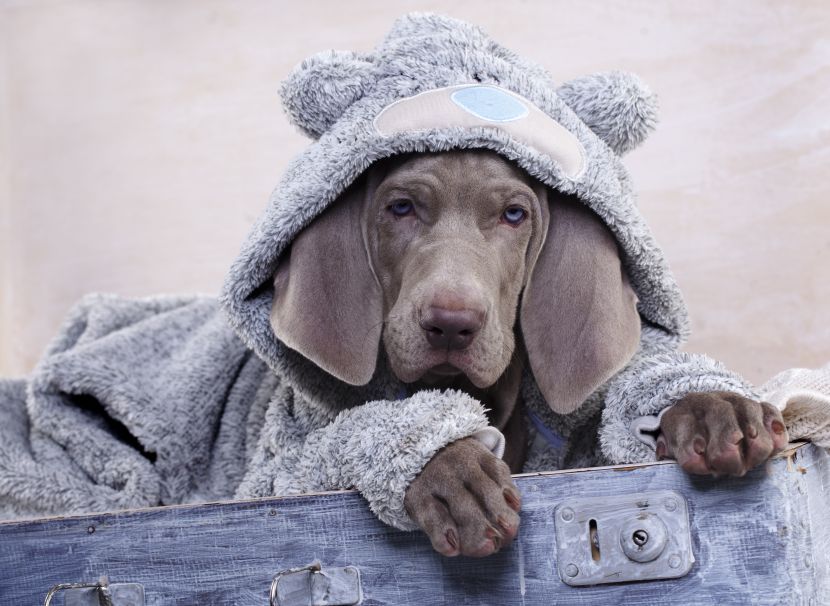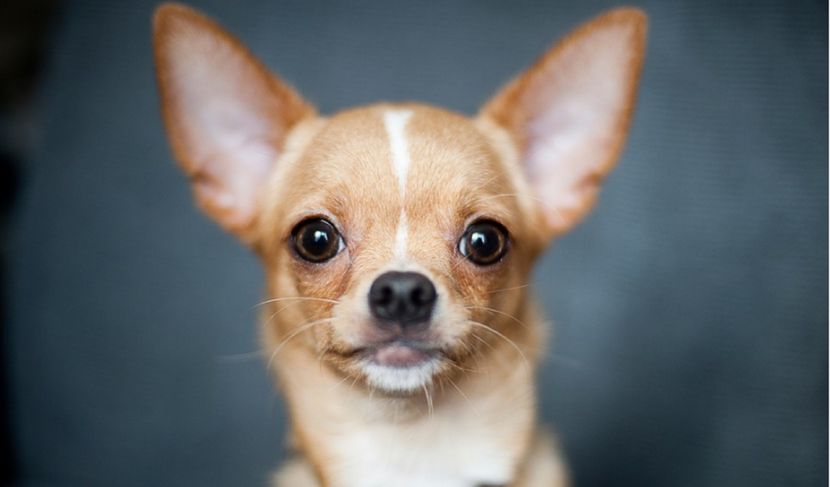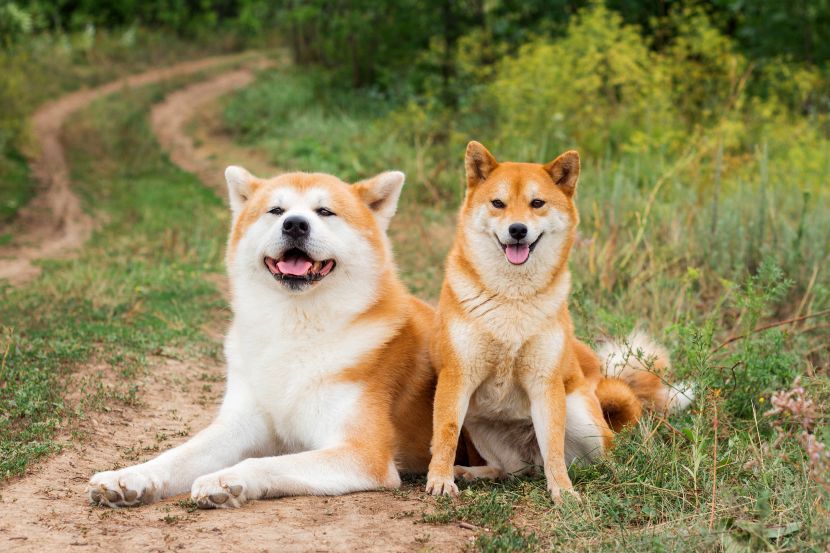
Experts claim that these breeds should not be on the wish list of future owners who have small children
Choosing the right breed of dog for your family is the most important thing and it is certain that you will find a dog that suits you among the 360 globally recognized breeds, but as a future owner, it is important not to choose a breed just because it is "trendy" or "looks cute" , advises Thesun.
Veterinarians around the world suggest that prospective dog owners thoroughly research breeds before welcoming a four-legged friend. Choosing the perfect dog breed requires even more thought if you have small children at home. Experts claim that these three dog breeds should not be on your wish list if you have children, and at the top of the forbidden list is the Weimaraner.

The Weimaraner was bred to hunt large game - a class of prey that, in size, looks similar to a child under the age of 13. Although this trait does not mean that the Weimaraner will constantly stalk a child, he does play rough with the people he lives with, especially if he is not getting enough attention or is not active. The Weimaraner needs a certain routine and lots of running, walking and playing. This can be difficult if you are a busy parent.Breed Standard
The Weimar Birdwatcher breed is known for its athletic build, sleek appearance, and excellent hunting capabilities. Recognized by several prestigious canine organizations, the breed standard requires a medium to large-sized dog, typically weighing between 55 to 90 pounds. Their muscular physique is complemented by their keen senses, particularly their exceptional eyesight, making them ideal for tracking and retrieving birds. The breed standard also emphasizes their balanced proportions, alert expression, and smooth gait, which all contribute to their striking and elegant look.
Breed Colors & Markings
The Weimar Birdwatcher comes in a variety of distinct colors and markings that make them stand out. The most common coat colors are shades of gray, silver, and blue-gray. These muted tones allow them to blend effortlessly into their natural surroundings when birdwatching or hunting. Some individuals may display a small white patch on their chest or toes, but solid coats are preferred by breeders. Their short, sleek coat not only enhances their appearance but also makes grooming easy, which adds to their appeal.
About the Breed
Known for their intelligence, the Weimar Birdwatcher is a versatile and energetic dog breed that excels in various roles, from family companion to skilled hunter. They are affectionate, loyal, and eager to please, making them excellent companions for active households. However, due to their strong instincts and need for mental stimulation, they thrive in environments where they can engage in activities like birdwatching, hiking, or agility training. This breed is best suited for experienced dog owners who can provide them with both physical and mental challenges.
Health
Maintaining the health of a Weimar Birdwatcher requires regular vet check-ups, a balanced diet, and plenty of exercises. This breed is generally healthy, but they can be prone to certain genetic conditions, such as hip dysplasia, bloat, and eye problems. Regular screenings for these issues are recommended to ensure early detection and treatment. Providing a nutritious diet and keeping your dog at an ideal weight can help reduce the risk of joint-related issues, ensuring your **Weimar Birdwatcher** lives a long, healthy life.
Grooming
Weimar Birdwatchers are relatively low-maintenance when it comes to grooming, thanks to their short, sleek coat. Brushing once or twice a week will help remove loose fur and keep their coat shiny and healthy. Regular ear cleaning is important to prevent infections, especially after outdoor activities like birdwatching or swimming. Nail trimming should also be done regularly to prevent discomfort or injury. Overall, grooming is straightforward, but consistency is key to keeping your **Weimar Birdwatcher** looking and feeling their best.
Exercise
As a highly active breed, the Weimar Birdwatcher requires plenty of exercises to keep them happy and healthy. Daily walks, play sessions, and time spent outdoors are essential for this energetic breed. They are natural hunters with a strong prey drive, so activities like birdwatching, tracking, and retrieving can provide the mental stimulation they need. Without adequate exercise, Weimar Birdwatchers can become bored and potentially destructive, so it's important to incorporate plenty of physical activity into their daily routine.
Training
Training a Weimar Birdwatcher is essential to channel their intelligence and energy in a positive direction. They are quick learners and respond well to positive reinforcement techniques, such as treats and praise. However, early training and socialization are crucial to ensure they grow into well-mannered, obedient dogs. Their strong hunting instincts may make them prone to chasing small animals, so leash training and recall commands are particularly important. Consistent training will help develop a strong bond between you and your dog.
Nutrition
Proper nutrition is key to maintaining the health and vitality of your Weimar Birdwatcher. A high-quality, well-balanced diet that is rich in protein will support their active lifestyle and muscular build. It's important to adjust portion sizes based on their activity level, as overfeeding can lead to obesity, which can exacerbate health issues like hip dysplasia. Regular consultations with a veterinarian can help determine the best diet plan for your individual dog, ensuring they receive all the necessary nutrients.
History
The Weimar Birdwatcher has a rich history that dates back to the 19th century, where it was originally bred for hunting large game. Over time, as hunting practices evolved, they were trained to specialize in birdwatching and retrieving game. This breed has deep roots in German aristocracy and was highly prized for its versatility, intelligence, and loyalty. Today, the Weimar Birdwatcher remains a popular choice for both hunters and families, maintaining their reputation as skilled birdwatchers and loving companions.

2. The second on the list of undesirable breeds for a family with children is smaller than the Weimaraner, but no less awkward: it is the Chihuahua. These purse dogs are small, but they are known for having mouths always ready to bite.
Many people think that Chihuahuas are ideal for families with small children, because the breed is very small, but the reality is quite the opposite. The Chihuahua relies on its teeth to protect it where its stature cannot, reacting by barking and sometimes biting. Many Chihuahuas need personal space: they will give a lot of signals if someone enters their zone and makes them feel uncomfortable. The problem with children and chihuahuas is that children are not good at reading signals, so chihuahuas become aggressive in no time.
About the Breed
The Chihuahua is one of the smallest dog breeds in the world, known for its big personality in a compact size. This toy breed is highly adaptable, making it an ideal pet for apartment living. Chihuahuas are loyal, affectionate, and alert, often forming strong bonds with their owners. Despite their size, they have a bold demeanor and are not afraid to stand their ground.
Breed Standard
According to the official breed standard, the Chihuahua should not weigh more than 6 pounds. They have an apple-shaped head, expressive eyes, and a slightly curved tail that is set high. Chihuahuas come in two coat varieties: smooth and long. Their compact, balanced build and proud stance make them easily recognizable in the dog world. The breed is judged on its size, proportions, and temperament, all of which contribute to its unique charm.
Breed Colors & Markings
Chihuahuas come in a variety of colors and markings. They can be solid, marked, or splashed with different hues. Popular colors include fawn, black, chocolate, and white, though they can also be blue, cream, or brindle. Markings like masks, spots, or patches further diversify their appearance. This variety in color makes every Chihuahua visually unique, adding to their appeal.
Health
Chihuahuas are generally a healthy breed, but they are prone to certain health issues, including heart problems, dental issues, and patellar luxation. Regular vet visits and a well-maintained healthcare routine can help mitigate these concerns. Owners should be vigilant about their pet's health, as early detection of issues can improve the quality of life for the dog.
Grooming
Grooming a Chihuahua is relatively simple. Smooth-coated Chihuahuas require minimal grooming, usually just regular brushing to remove loose hairs. Long-coated Chihuahuas need more frequent brushing to avoid tangles and mats. Both varieties benefit from routine dental care, as Chihuahuas are prone to dental disease. Bathing should be done as needed, and nails should be trimmed regularly.
Exercise
Despite their small size, Chihuahuas need regular exercise to stay fit and healthy. Daily walks and playtime are essential to keep them mentally and physically stimulated. They have bursts of energy and enjoy activities that challenge them. However, they can also be prone to laziness, so it’s important for owners to ensure they get enough exercise without overexertion.
Training
Chihuahuas are intelligent dogs, but their independent nature can sometimes make training a challenge. Consistency and positive reinforcement are key to training success. Early socialization is essential to prevent small dog syndrome, where the Chihuahua may try to assert dominance despite its size. With patience and firm but kind training methods, Chihuahuas can learn commands, tricks, and good behavior.
Nutrition
Proper nutrition is vital for a Chihuahua’s health. Because they are small, they have fast metabolisms and need nutrient-dense meals. A high-quality diet rich in protein, healthy fats, and essential vitamins will keep their coat shiny, maintain energy levels, and support overall well-being. Portion control is crucial, as obesity can lead to other health problems in this breed.
History
The Chihuahua’s history is rich and mysterious. The breed is believed to have descended from the Techichi, a small companion dog favored by ancient civilizations in Mexico. Chihuahuas gained global popularity in the 20th century, becoming beloved pets and companions worldwide. Their association with Mexican culture and their status as a fashionable pet has solidified their place in the hearts of dog lovers everywhere.

3. The Akita, a large Japanese mountain dog, is the third least family-friendly breed. Experts say the Akita can be very kind and loyal, but it is a breed that has been bred for years to be a watchdog. The Akita's instincts are very easily reversed in play and when unfamiliar children come into your home. The Akita wants to protect her family, including your children, so she may perceive the arrival of other children as a threat, and sometimes equate your children's rude behavior or noise with unpleasant experiences she has had with other children. The natural instinct of the guardian akita is then activated and attacks and injuries occur.
The same rules that apply to the above three breeds of dogs also apply if you don't have small children at home, but they come to visit you. If they do not know how to behave properly in a house where a dog of one of the mentioned breeds lives, their mischief, squeals and screams will awaken defensive responses in these dogs.
The Akita is a noble and powerful dog breed with deep roots in Japan. Known for their loyalty, courage, and imposing appearance, Akitas are often regarded as excellent family protectors. Below, we explore the most important aspects of the Akita breed.
About the Breed
Akitas are a large and sturdy dog breed, originally bred for hunting and guarding. They are characterized by their broad heads, erect ears, and curled tails. The Akita is a confident and intelligent breed, with a reserved and dignified temperament. They are often described as independent yet fiercely loyal to their family.
Breed Standard
The Akita breed standard emphasizes strength, balance, and a commanding presence. Adult males typically weigh between 100-130 pounds, while females range from 70-100 pounds. They have a double coat with a thick, plush undercoat and a harsh outer coat. Their large, triangular ears stand erect, giving them a sharp, alert appearance. The tail curls over the back, a signature feature of the Akita breed.
Breed Colors & Markings
Akitas come in a wide variety of colors and markings, which are well-documented in the breed standard. Common colors include white, brindle, and variations of red and fawn. Akitas may have a mask or blaze markings on their face, particularly in the American Akita. The color variations are more limited in the Japanese Akita, where a uniform appearance is preferred.
History
The history of the Akita is rich and fascinating. Originating from the mountainous regions of northern Japan, the breed was initially developed as a hunting dog for large game, such as boar and bears. In the early 20th century, Akitas were revered as national treasures in Japan. The breed was later divided into two distinct types: the American Akita and the Japanese Akita Inu, each with its own unique characteristics.
Health
Akitas are generally a healthy breed, but like all dogs, they are prone to certain hereditary health conditions. Common health concerns include hip dysplasia, autoimmune disorders, and progressive retinal atrophy. Regular veterinary check-ups and responsible breeding practices can help mitigate these risks. A healthy Akita can live between 10-15 years.
Grooming
Akitas are a double-coated breed, which means they shed heavily, especially during seasonal changes. Regular grooming is essential to keep their coat healthy and reduce shedding. Brushing your Akita at least twice a week will help keep their coat free from tangles and dirt. During shedding season, daily brushing is recommended.
Exercise
Exercise is crucial for Akitas to maintain their physical and mental health. These dogs are active and need at least one to two hours of physical activity each day. Regular walks, play sessions, and even tasks like agility training can help keep your Akita engaged and fit. Lack of exercise can lead to boredom and behavioral issues.
Training
Akitas are intelligent and strong-willed, so early training is essential. Socialization from a young age will help them develop into well-rounded adults. Positive reinforcement techniques work best with Akitas, as they can be stubborn. Consistent, firm, yet patient training will help them respond well to commands.
Nutrition
Nutrition plays a key role in an Akita's overall health. A high-quality, balanced diet that includes protein, healthy fats, and essential nutrients is crucial for this breed. Portion control is important, as Akitas are prone to obesity if overfed. Consult your veterinarian to determine the appropriate diet and portion sizes for your individual dog.
With their powerful build and loyal nature, Akitas make for remarkable companions. Understanding the breed's unique needs, from grooming to training, will help you raise a healthy and happy Akita.


